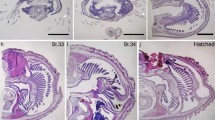Summary
Present information places the circulatory performance ofNautilus at the bottom of the cephalopod scale but shows it to be distinctly different from that of gastropods and bivalves. The feature which clearly places it closer to its coleoid relatives than to other groups of molluscs is the enhancement of the branchial circulation by the beating pericardial glands and renal appendages. These organs have their homologues in the coleoid pericardial chamber. Recently, studies of living embryos show that the development of a functional circulatory system is an early event during ontogeny and that this information may have important implications for our understanding of the evolution of a branchial circulation.
Similar content being viewed by others
References
Arnold, J.M., and Carlson, B.A., LivingNautilus embryos: preliminary observations. Science232 (1986) 73–76.
Arnold, J.M., and Williams-Arnold, L.D., Sperminogenesis ofNautilus pompilius. I. General survey. J. exp. Zool.205 (1978) 13–26.
Bidder, A., Use of tentacles, swimming and buoyancy in the pearlyNautilus. Nature196 (1962) 451–454.
Bourne, G. B., Blood pressure in the squid,Loligo pealei, Comp. Biochem. Physiol.72A (1982) 23–27.
Bourne, G.B., Chronic examination of the heartbeat in three species of gastropod. Am. Zool.23 (1983) 918.
Bourne, G.B., Pressure-Flow relations in the post-systemic circulation of the squid,Loligo pealei. Comp. Biochem. Physiol.78A (1984) 307–313.
Bourne, G.B., and Redmond, J.R., Hemodynamics in the pink abalone,Haliotis corrugata (Mollusca, Gastropoda). I. Pressure relations and pressure gradients in intact animals. J. exp. Zool.200 (1977) 9–16.
Bourne, G.B., Redmond, J. R., and Johansen, K.,Nautilus pompilius: branchial circulation enhanced by an auxiliary pumping mechanism. Experientia33 (1977) 1453.
Bourne, G.B., Redmond, J.R., and Johansen, K., Some aspects of hemodynamics inNautilus pompilius. J. exp. Zool.205 (1978) 63–70.
Dykens, J.A., Mangum, C.P., and Arnold, J.M., A note on the structural organization of the cardiac myofiber inNautilus pompilius. Pac. Sci.36 (1982) 267–271.
Ellington, W.R., Energy metabolism during hypoxia in the isolated, perfused ventricle of the whelk,Busycon contrarium. J. comp. Physiol.142 (1981) 457–464.
Frank, O., Die Grundform des arteriellen Pulses. Erste Abhandlung. Mathematis Analyse. Z. Biol.37 (1899) 483–526.
Gosline, J.M., and Shadwick, R.E., The biomechanics of the arteries ofNautilus, Nototodarus, andSepia. Pac. Sci.36 (1982) 283–296.
Griffin, L.E., The anatomy ofNautilus pompilius. Mem. natn. Acad. Sci. Wash.8 (1900) 103–197, 17 plates.
Hochachka, P.W., French, C.J., and Meredith, J., Metabolism and ultrastructural organization inNautilus muscles. J. exp. Zool.205 (1978) 51–62.
Johansen, K., and Martin, A.W., Circulation in the cephalopod,Octopus dofleini. Comp. Biochem. Physiol.5 (1962) 161–176.
Johansen, K., Redmond, J.R., and Bourne, G.B., Respiratory exchange and transport of oxygen inNautilus pompilius. J. exp. Zool.205 (1978) 27–36.
Mangum, C.P., and Towle, D.W., TheNautilus siphuncle as an ion pump. Pac. Sci.36 (1982) 273–282.
Martin, A.W., Physiology of excretory organs of cephalopods. Fortschr. Zool.23 (1975) 112–123.
Naef, A., Studien zur generellen Morphologie der Mollusken. 2. Teil: Das Colomsystem in seinen topographischen Beziehungen. Ergebn. Fortschr. Zool.3 (1913) 329–462.
Owen, R., Memoir on the Pearly Nautilus (Nautilus pompilius Linn.). Richard Taylor, London 1832.
Packer, A., Bone, Q., and Hignette, M., Breathing and swimming movements in a captiveNautilus. J. mar. Biol. Ass. U.K.60 (1980) 313–327.
Redmond, J.R., and Bourne, G.B., Vascular resistance in the isolated gills ofOctopus macropus andNautilus pompilius. Pac Sci.36 (1982) 297–303.
Schipp, R., and Martin, A.W., Cytology of the renal appendages ofNautilus, (Cephalopoda, Tetrabranchiata) Cell Tissue Res.219 (1980) 585–596.
Shadwick, R.E., and Gosline, J.M., Elastic arteries in invertebrates: mechanics of the octopus aorta. Science213 (1981) 759–761.
Ward, P., Stone, R., Westermann, G., and Martin, A., Notes on animal weight, cameral fluids, swimming speed, and colour polymorphism of the cephalopodNautilus pompilius in the Fiji islands. Paleobiology3 (1977) 377–388.
Wells, M.J., The heartbeat ofOctopus vulgaris. J. exp. Biol.78 (1979) 87–104.
Wells, M.J., and Wells, J., Ventilation and oxygen uptake byNautilus. J. exp. Biol.118 (1985) 297–313.
Willey, A., Contributions to the natural history of the nautilus. Zool. Res.6 (1902) 736–830.
Author information
Authors and Affiliations
Rights and permissions
About this article
Cite this article
Bourne, G.B. Circulatory physiology ofNautilus. Experientia 43, 484–486 (1987). https://doi.org/10.1007/BF02143576
Published:
Issue Date:
DOI: https://doi.org/10.1007/BF02143576




